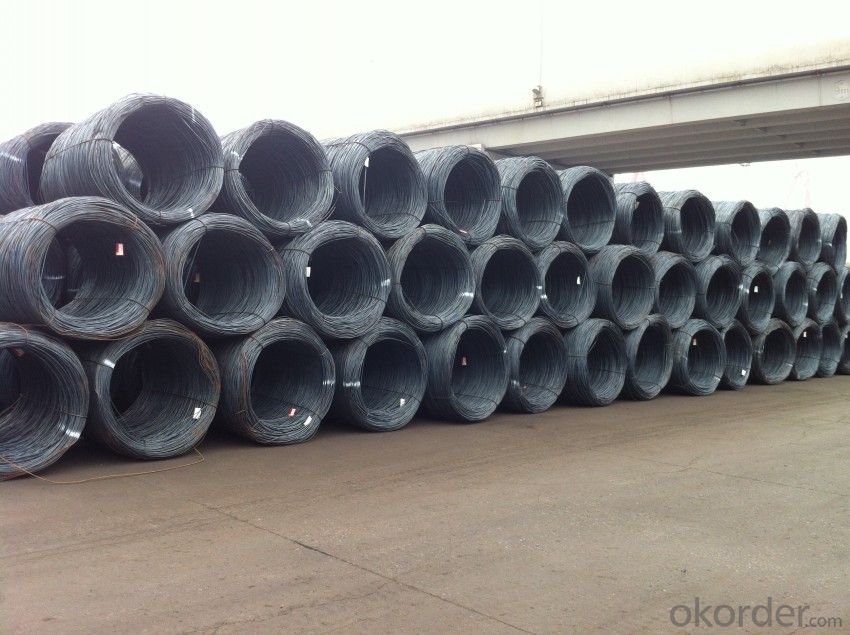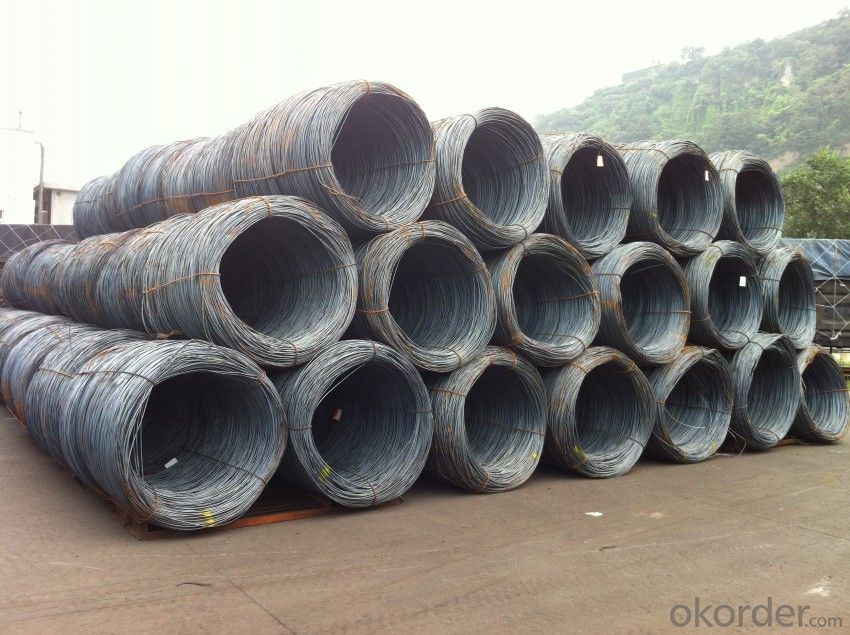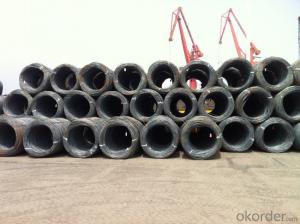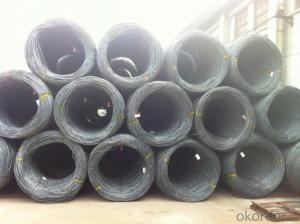Hot Rolled Wire rods with highest quality and lowest price
- Loading Port:
- Tianjin
- Payment Terms:
- TT OR LC
- Min Order Qty:
- 25 m.t.
- Supply Capability:
- 10000 m.t./month
OKorder Service Pledge
OKorder Financial Service
You Might Also Like
Product Description:
OKorder is offering Carbon Steel Wire Rod at great prices with worldwide shipping. Our supplier is a world-class manufacturer of steel, with our products utilized the world over. OKorder annually supplies products to European, North American and Asian markets. We provide quotations within 24 hours of receiving an inquiry and guarantee competitive prices.
Product Applications:
Carbon Steel Wire Rod are ideal for structural applications and are widely used in the construction of buildings and bridges, and the manufacturing, petrochemical, and transportation industries.After hot-rolled the products shaped into coil and delivery as finished product, including round, square, rectangular, hexagonal and so on. Since most of the products are round, it is generally called wire rod. Carbon steel wire rod is widely used in construction and manufacturing. Carbon steel wire rod is mainly used for reinforcement of reinforced concrete and welded structure or reprocessed (roberts , nail, etc.) materials, especially used to produce wire drawing, welding electrode, nails, spring, electronic, precise machinery parts and so on.
Product Advantages:
OKorder's Carbon Steel Wire Rod are durable, strong, and resist corrosion.
Main Product Features:
· Premium quality
· Prompt delivery & seaworthy packing (30 days after receiving deposit)
· Corrosion resistance
· Can be recycled and reused
· Mill test certification
· Professional Service
· Competitive pricing
Product Specifications:
Chemical Composition:
Please kindly find our chemistry of our material based on SAE1006/SAE1008 as below for your information
Grade | Chemical Composition (%) | |||||
C | Mn | S | P | Si | B | |
SAE1006B | 0.03~O.07 | 0.32max | 0.045max | 0.040max | 0.30max | 0.0008min |
Mechanical properties | ||||||
Yield strength(N/mm2) | Tensile strength(N/mm2) | Elongation (%) | ||||
250-280 | 350-380 | ≥32 | ||||
Grade | Chemical Composition (%) | |||||
C | Mn | S | P | Si | B | |
SAE1008B | 0.10max | 0.3~0.50 | 0.050max | 0.040 max | 0.15max | 0.0008 min |
Mechanical properties | ||||||
Yield strength(N/mm2) | Tensile strength(N/mm2) | Elongation (%) | ||||
≥195 | 315-430 | ≥30 | ||||
FAQ:
Q1: Why buy Materials & Equipment from OKorder.com?
A1: All products offered byOKorder.com are carefully selected from China's most reliable manufacturing enterprises. Through its ISO certifications, OKorder.com adheres to the highest standards and a commitment to supply chain safety and customer satisfaction.
Q2: How do we guarantee the quality of our products?
A2: We have established an advanced quality management system which conducts strict quality tests at every step, from raw materials to the final product. At the same time, we provide extensive follow-up service assurances as required.
Q3: How soon can we receive the product after purchase?
A3: Within three days of placing an order, we will begin production. The specific shipping date is dependent upon international and government factors, but is typically 7 to 10 workdays.
Image


- Q:How is steel wire rod used in the production of wire ropes for cranes?
- Steel wire rod is a crucial component in the production of wire ropes for cranes. Wire ropes used in cranes require high tensile strength, durability, and flexibility to withstand heavy loads and frequent usage. Steel wire rods, which are typically produced from carbon steel or alloy steel, provide these necessary characteristics. The first step in the production of wire ropes involves the drawing process. Steel wire rods are drawn through a series of dies to reduce their diameter and increase their length. This process, known as cold drawing, not only refines the wire rod's surface finish but also enhances its tensile strength. By subjecting the wire rod to this process, it becomes thinner, longer, and stronger. After the cold drawing process, the wire rod is further processed to form individual wires. These wires are then helically laid around a core in a specific pattern, forming strands. The number and arrangement of strands depend on the desired strength and flexibility of the wire rope. The steel wire rod's high tensile strength ensures that the resulting wires and strands can withstand the considerable forces involved in crane operations. Once the strands are formed, they are carefully laid together around a central core to create the final wire rope. The steel wire rod's durability and flexibility allow the wire rope to withstand bending, twisting, and stretching without breaking or losing its shape. This is essential for cranes, as they often operate in harsh conditions and are subjected to repetitive cycles of heavy lifting. Additionally, the steel wire rod used in wire rope production undergoes various heat treatment processes to enhance its mechanical properties. This treatment modifies the steel's microstructure, increasing its strength and toughness. Heat treatment processes such as annealing, quenching, and tempering ensure that the wire rope can endure the demanding working conditions of cranes. In summary, steel wire rod plays a vital role in the production of wire ropes for cranes. Its high tensile strength, durability, and flexibility are crucial for withstanding heavy loads and frequent usage. The steel wire rod undergoes various processes such as cold drawing and heat treatment to enhance its mechanical properties, ensuring that the resulting wire rope can withstand the demanding operations of cranes.
- Q:What are the different surface protection methods for steel wire rod?
- There exists a variety of surface protection methods for steel wire rods, each with different levels of protection and suitability for various applications. Some commonly used methods include: 1. Galvanization: The application of a zinc coating to the surface of the steel wire rod. Galvanization provides exceptional corrosion resistance, safeguarding the steel against moisture and chemicals. It is widely employed for outdoor or corrosive environments. 2. Coating: Steel wire rods can be coated with materials like epoxy, PVC, or polyethylene. These coatings act as a barrier between the steel surface and external factors, preventing corrosion and abrasion. They also enhance the wire's resistance to chemicals, UV radiation, and other damaging elements. 3. Phosphating: An approach that involves applying a phosphate coating to the steel wire rod. This process creates a thin layer of phosphate crystals, improving adhesion for subsequent coatings or paints. Phosphating also offers some corrosion resistance. 4. Electroplating: A method that deposits a thin layer of metal onto the steel wire rod through electrochemical means. Commonly used metals for electroplating include zinc, nickel, and chromium. This technique enhances the wire's resistance to corrosion, wear, and tarnishing. Furthermore, it adds aesthetic appeal, making it suitable for decorative purposes. 5. Powder coating: This approach entails the electrostatic application of a dry powder onto the steel wire rod, followed by curing under heat. The powder melts, forming a protective coating on the wire's surface. Powder coating provides excellent durability, resistance to corrosion, chemicals, and UV radiation. Moreover, it offers a wide range of color options and a smooth, attractive finish. Selecting the appropriate surface protection method for steel wire rods is crucial and should be based on specific requirements and the intended environment. Factors such as corrosion resistance, abrasion resistance, aesthetics, and cost-effectiveness must be considered when determining the most suitable method.
- Q:What are the different surface defects that can impact the bending properties of steel wire rod?
- There are several different surface defects that can impact the bending properties of steel wire rod. Some common defects include cracks, scales, pits, and scratches. These defects can weaken the structural integrity of the wire rod, leading to a decrease in its bending properties. It is important to address and minimize these defects to ensure the wire rod's quality and performance.
- Q:How is steel wire rod used in the manufacturing of wire forms for lighting fixtures?
- Wire forms for lighting fixtures rely on steel wire rod as a crucial component in their production. This wire rod serves as the primary raw material for crafting various wire forms, such as hooks, frames, and brackets, which are integral to the structure and functionality of lighting fixtures. The manufacturing process of steel wire rod begins with a series of steps. Initially, the wire rod undergoes wire drawing, wherein it is drawn through a series of dies to decrease its diameter and increase its length. This process results in a wire that is smooth, uniform, and of the desired thickness. After the wire has been drawn, it undergoes further processing to create the specific wire forms needed for lighting fixtures. This involves bending, shaping, and cutting the wire to the desired dimensions. To achieve the desired shapes and sizes, various tools and equipment, such as wire forming machines and presses, are utilized. The wire forms crafted from the steel wire rod are then integrated into the production of lighting fixtures. For example, hooks made from these wire forms are used to suspend the fixtures from the ceiling or wall mountings. Frames created from the wire forms provide structural support and hold the components of the lighting fixture in place. Brackets made from the wire forms are employed to attach the fixture to the wall or ceiling. Furthermore, the wire forms made from steel wire rod often serve as decorative elements in lighting fixtures. These wire forms can be shaped into intricate designs and patterns that enhance the aesthetics of the fixture. Various curves, loops, and spirals can be formed to create visually appealing and unique lighting designs. In conclusion, steel wire rod plays a vital role in the manufacturing process of wire forms for lighting fixtures. It offers the necessary strength, durability, and versatility required to create functional and visually appealing lighting fixtures.
- Q:What are the main factors driving the demand for steel wire rod?
- The main factors driving the demand for steel wire rod include the growth of various industries such as construction, automotive, and manufacturing, as well as the increasing demand for infrastructure development. Additionally, the rise in urbanization, population growth, and technological advancements also play a significant role in driving the demand for steel wire rod.
- Q:What are the different types of steel wire rod coatings used for electrical conductivity?
- There are several different types of steel wire rod coatings used for electrical conductivity, each with its own unique characteristics and advantages. One common type of coating used for electrical conductivity is copper. Copper has excellent electrical conductivity properties, making it an ideal choice for applications requiring high electrical performance. Copper coatings can be applied through various methods such as electroplating or hot-dipping, ensuring a uniform and durable coating on the steel wire rod. Another type of coating used for electrical conductivity is silver. Silver is known for its exceptional electrical conductivity, even better than copper. It is often used in applications where the highest level of electrical performance is required, such as in high-frequency cables or precision electronic components. Silver coatings can be applied through electroplating or electroless plating processes, providing a thin and highly conductive layer on the steel wire rod. Zinc is another commonly used coating for electrical conductivity, although it may not possess the same level of conductivity as copper or silver. Zinc coatings are often used for corrosion protection in electrical applications, as they provide a sacrificial layer that prevents the underlying steel wire rod from corroding. Additionally, zinc coatings can also enhance the electrical conductivity of the steel wire rod to some extent. Tin coatings are also utilized for electrical conductivity purposes. Tin is known for its low electrical resistance and good corrosion resistance properties. Tin coatings can be applied through electroplating or hot-dipping processes, providing a reliable and conductive layer on the steel wire rod. Lastly, there are also specialized coatings such as nickel or gold that can be used for specific applications requiring unique electrical conductivity properties. Nickel coatings offer good electrical conductivity and corrosion resistance, making them suitable for various electrical and electronic applications. Gold coatings, on the other hand, are highly conductive and provide excellent corrosion resistance, making them ideal for high-end electronic components or connectors. In conclusion, the different types of steel wire rod coatings used for electrical conductivity include copper, silver, zinc, tin, nickel, and gold. Each coating offers specific advantages and is chosen based on the desired level of electrical performance, corrosion resistance, and application requirements.
- Q:What are the different surface finishing materials used for steel wire rod?
- There are several surface finishing materials used for steel wire rod, each offering unique properties and benefits. Some of the commonly used surface finishing materials for steel wire rod include: 1. Zinc Coating: Zinc coating, also known as galvanizing, is one of the most common surface finishing materials used for steel wire rod. It involves applying a layer of zinc to the surface of the wire rod through a hot-dip or electroplating process. Zinc coating provides excellent corrosion resistance and acts as a sacrificial anode, protecting the underlying steel from rust and corrosion. 2. Phosphate Coating: Phosphate coating is another widely used surface finishing material for steel wire rod. It involves treating the wire rod with a phosphate solution, which creates a thin layer of phosphate crystals on the surface. Phosphate coating improves the adhesion of subsequent coatings, such as paint or powder coating, and provides enhanced corrosion resistance. 3. Epoxy Coating: Epoxy coating is a thermosetting polymer that is applied as a protective layer on the surface of steel wire rod. It provides excellent resistance against chemicals, abrasion, and corrosion. Epoxy coating also improves the wire rod's durability and extends its service life. 4. Powder Coating: Powder coating is a popular surface finishing method that involves electrostatically applying a dry powder to the steel wire rod's surface. The powder is then cured under heat, forming a hard and durable coating. Powder coating offers a wide range of colors and finishes, improved resistance to chipping and scratching, and enhanced corrosion protection. 5. Chrome Plating: Chrome plating is a surface finishing process that involves depositing a layer of chromium onto the steel wire rod's surface. Chrome plating provides excellent corrosion resistance, wear resistance, and a decorative finish. It is commonly used in applications where aesthetics, durability, and corrosion protection are crucial. 6. Nickel Plating: Nickel plating is another surface finishing material used for steel wire rod. It involves depositing a layer of nickel onto the wire rod's surface, providing enhanced corrosion resistance and a bright finish. Nickel plating also improves the wire rod's solderability and facilitates better electrical conductivity. These are just a few examples of the different surface finishing materials used for steel wire rod. The choice of coating or plating depends on the specific requirements of the application, such as corrosion resistance, aesthetics, and functional properties.
- Q:What are the standard tolerances for steel wire rod?
- The standard tolerances for steel wire rod can vary depending on the specific requirements and regulations set by industry standards and manufacturers. However, some common tolerances for steel wire rod include diameter tolerances within a specific range (e.g., ±0.05mm), straightness tolerances (e.g., 0.2mm/m), and surface quality tolerances (e.g., limited defects or imperfections). It is important to consult the specific standards or specifications provided by the manufacturer or relevant industry guidelines for accurate information on the standard tolerances for steel wire rod.
- Q:What are the different surface defects that can impact the tensile strength of steel wire rod?
- Some of the different surface defects that can impact the tensile strength of steel wire rod include scratches, cracks, pits, and scale. These defects can weaken the structure of the wire rod and reduce its ability to withstand tension, resulting in a lower tensile strength.
- Q:What are the common quality control tests performed on steel wire rod?
- Some common quality control tests performed on steel wire rods include dimensional measurements, tensile strength testing, surface inspection for defects or imperfections, chemical composition analysis, and ultrasonic testing for internal defects.
1. Manufacturer Overview |
|
|---|---|
| Location | |
| Year Established | |
| Annual Output Value | |
| Main Markets | |
| Company Certifications | |
2. Manufacturer Certificates |
|
|---|---|
| a) Certification Name | |
| Range | |
| Reference | |
| Validity Period | |
3. Manufacturer Capability |
|
|---|---|
| a)Trade Capacity | |
| Nearest Port | |
| Export Percentage | |
| No.of Employees in Trade Department | |
| Language Spoken: | |
| b)Factory Information | |
| Factory Size: | |
| No. of Production Lines | |
| Contract Manufacturing | |
| Product Price Range | |
Send your message to us
Hot Rolled Wire rods with highest quality and lowest price
- Loading Port:
- Tianjin
- Payment Terms:
- TT OR LC
- Min Order Qty:
- 25 m.t.
- Supply Capability:
- 10000 m.t./month
OKorder Service Pledge
OKorder Financial Service
Similar products
New products
Hot products
Related keywords




























